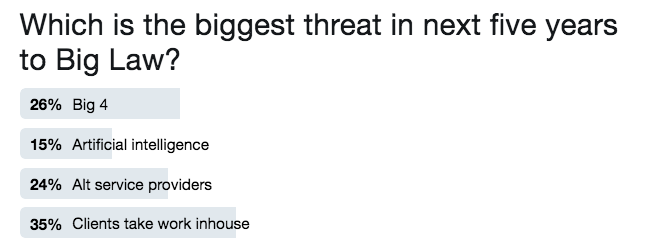What is the current state of legal AI (artificial intelligence) – the Q&A below has my views.
[Baretz + Brunelle, an agency supporting Bloomberg Law asked these questions in August, prior to ILTACon. Portions of my answers appeared in two B+B sponsored Bloomberg Big Law Business posts: Is Artificial Intelligence No Longer Cutting Edge? (Aug 14) and Beyond the Hype in AI: Implementing and Maintaining Artificial Intelligence (Aug 18). To that text, I added my Twitter poll about the biggest threat to Big Law.]
Q: What does it take to roll out AI initiatives in legal? What do you need to have in order to get support and implement?
A: One answer is that it’s easy. All it takes is budget to license software and some IT support to deploy it. Law firms and law departments have decades of experience evaluating and deploying a range of practice technologies. It’s not obvious we should view AI differently.
Another answer is that it’s hard. AI is potentially transformative and therefore different, requiring special attention. I explain both briefly….
It’s Easy. There are at least four common artificial intelligence uses for which firms or law department can easily license commercial-off-the-shelf AI software and deploy in a manner similar to other practice technologies:
- Document review in e-discovery (“predictive coding”)
- Contract due diligence review in corporate transactions
- Third party legal research products in multiple practice areas
- Time entry and matter analysis
All four uses address clearly defined problems lawyers face. All four have multiple providers that offer off-the-shelf software. These products are straightforward to deploy from both the IT or user training / adoption perspective. Many lawyers have used predictive coding for years. One software company that provides software to accelerate due diligence reviews, Kira Systems, recently publicly stated in August that it has over 200 law firm licensees that run 1,000 projects per month. And AI-driven legal research products have seen rapid uptake. Deploying AI is no longer cutting edge.
What it takes to get support and implement is (A) having a problem that an AI product solves, (B) the ability to analyze the economic pros and cons of the solution to reach a financially sensible decision, (C) a willingness to run a proof of concept and or pilot to empirically test candidate products, (D) budget and available IT resources to deploy, and (E) a plan for user adoption. These are the same considerations for other practice and business problems that technology can address. Stopping here, however, misses a key point…
It’s Hard. AI has the potential to transform law practice. For one example of the likely transformation of law practice, see a white paper my Fireman & Company colleagues and I released in August, Transforming How Lawyers Work: AI-Enabled Document Management.
Given the big potential, many firms are, at minimum, tracking AI developments so they can leap-in at an appropriate moment. Others are more actively exploring uses beyond the four I outlined above. Some firms see sufficient potential in AI that they are spending what, in essence, is R&D dollars to evaluate the potential.
That eagerness to stay current and willingness to invest is what separates AI from prior practice technologies. I’ve been doing legal tech for almost three decades. None of the prior big transformations I’ve live through – PCs, local area networks, the Internet, the rise of social media, or the advent of cloud computing – have grabbed legal market attention the way AI has.
Staying current on AI is relatively easy, especially given wide coverage in the legal market (including my artificial intelligence Tweets and blog posts). But acting can be hard: R&D mentality in law firms is only now emerging; coming up with unique solutions and approaches may be hard; and changing the business model, which is often implied, is particularly hard.
Q: Are law firms getting more savvy about their AI strategies or are most not even there yet?
A: Many are plenty savvy. They have licensed commercial software and rolled it out to lawyers. They continue to evaluate competing products and new product categories. Some, as mentioned, are even doing R&D. The boldest may even ‘roll their own’ with the big array of open-source (read free) AI tools from Google, Facebook, or Amazon. (There is now even legal-specific open-source AI: LexPredict released this summer ContraxSuite, for contract analytics and due diligence.)
Over time, I expect all firms will consider AI. The best analogy is the advent of PCs and then the Internet. Some firms started very early with both, others started very late with both. There is some evidence today that market rewards early adoption but the case to pursue AI for every firm may not be obvious. Like many other business opportunities, the attractiveness will vary based on practice- and organization- specific considerations.
That said, in my view, lawyers and legal organizations that want to prosper – whether in high volume or high stakes legal work – must invest to reduce delivery cost. The client demand for value is all about reducing deliver cost, whether with better scoping, delegation to lower cost labor, or using technology to improve lawyer efficiency. AI will play an outsized roll reducing legal delivery cost. As more firms accept the market reality that must reduce cost (and improve service), more will embrace AI.
Q: What are some of the best ways/easy points of entry for law firms/law departments to leverage AI?
A: All of the four uses I mention in my first answer are easy entry points.
Q: Over the next 12 months, do you think the hype around AI will lessen and we will start seeing more practical applications – in law firms and legal depts.?
A: We already see numerous practical applications of artificial intelligence today. For a relatively new technology, it seems to me there are many vendors and uses already.
To achieve its full potential will require more planning and work today. Specifically, it works best with large volumes of “clean” data. Many legal organizations can do a better job collecting and normalizing data. For example, every law firm and law department should systematically track case outcomes. Today we know much more about inputs than outcomes. To use AI to help improve outcomes, we must track them. Unless we as an industry get better at collecting relevant data in consistent ways, we won’t achieve the full promise of AI.
The hype may well continue but unless we channel it to both concrete results and in ways that focus on actual problems to solve, we risk disappointment. Even if that happens, the smart firm and law departments will continue to invest to reduce delivery cost and improve outcomes.
Since writing the above last August, over the last week I conducted a poll on Twitter about the biggest threat to Big Law in the next five years. Twitter only allows four choices and the demographics of the 200+ respondents is unknown. At least among these voters, AI is smallest threat of the four:
Which is the biggest threat in next five years to Big Law?
— ronfriedmann (@ronfriedmann) September 27, 2017
Static results of poll:


Archives
Blog Categories
- Alternative Legal Provider (44)
- Artificial Intelligence (AI) (57)
- Bar Regulation (13)
- Best Practices (39)
- Big Data and Data Science (14)
- Blockchain (10)
- Bloomberg Biz of Law Summit – Live (6)
- Business Intelligence (21)
- Contract Management (21)
- Cool Legal Conferences (13)
- COVID-19 (11)
- Design (5)
- Do Less Law (40)
- eDiscovery and Litigation Support (165)
- Experience Management (12)
- Extranets (11)
- General (194)
- Innovation and Change Management (188)
- Interesting Technology (105)
- Knowledge Management (229)
- Law Department Management (20)
- Law Departments / Client Service (120)
- Law Factory v. Bet the Farm (30)
- Law Firm Service Delivery (128)
- Law Firm Staffing (27)
- Law Libraries (6)
- Legal market survey featured (6)
- Legal Process Improvement (27)
- Legal Project Management (26)
- Legal Secretaries – Their Future (17)
- Legal Tech Start-Ups (18)
- Litigation Finance (5)
- Low Cost Law Firm Centers (22)
- Management and Technology (179)
- Notices re this Blog (10)
- Online Legal Services (64)
- Outsourcing (141)
- Personal Productivity (40)
- Roundup (58)
- Structure of Legal Business (2)
- Supplier News (13)
- Visual Intelligence (14)
